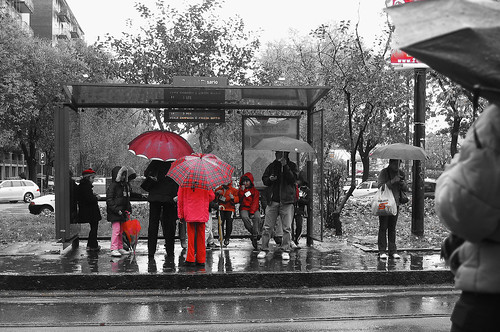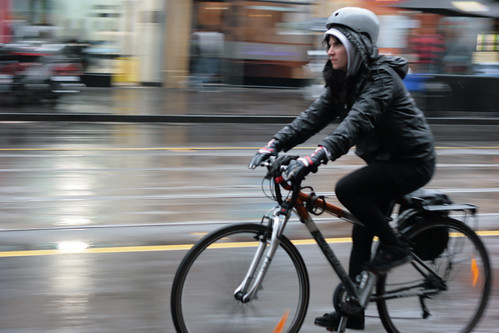
usadifranci
Related Posts:
> Getting the most out of using bikes and public transport together
Notes:
- We have two north-south tram lines around 200m to our west and east.
- We have a train line to the CBD around 1km to the east.
Details:
1. Commuting to work when the weather is bad
- In my present circumstances, my workplace is only 3.8km from home (a 10-13min ride) and I have had to resort to public transport no more than twice a year. I use the tactics listed here to ride as often as possible: How to avoid getting wet when riding. However, bad weather (rain, snow, high winds or temperature extremes) is definitely the single biggest reason most cyclists need a public transport option. Riding in bad weather isn't pleasant and for longer trips, or where your clothing is most affected, it may not even be feasible.
- An efficient, reliable public transport alternative allows you to not cycle when the weather gets in the way. When first starting out you may elect not to ride during winter at all or for periods of unsuitable weather. Over time, as you become better adjusted to dealing with the weather, you will find you need public transport less and prefer riding even when the weather isn't perfect.
- Often you may come out of work to find the weather has become unsuitable and you can simply leave your bike at work overnight.

baudman 
2. Carrying changes of clothes to/from work
- Many cycling commuters have places to store their work clothes at work and get changed at their workplace. This necessitates having to regularly ferry a significant amount of clothing home to get washed. This is possible on a bike but many people find it more convenient to make a couple of trips a week on public transport to carry clothes and other gear.
- Before I started wearing comfortable, casual clothing to work all the time (jeans, sweaters, boots) I used to keep my suits, shirts and shoes in a locker at work. Catching a tram at the end and beginning of the week allowed me to easily get my work clothes home to be washed.
3. Getting around with young children
- We don't have kids yet but it obviously is much more difficult to get by without a car and only relying on walking and cycling. Efficient access to suitable public transport that can get you to necessary destinations seems quite critical.
4. Going longer distances or more challenging trips with a partner or friends
- It's rare that both partners or every friend going somewhere will all prefer to cycle or find it as enjoyable. On trips that are longer or are more challenging (e.g. sharing busy roads, not familiar routes) my girlfriend often prefers to take public transport. Thus, having a public transport alternative works out nicely for both of us.
5. Going out at night with a partner to destinations further away
- Cycling at night on shared roads (especially less familiar or busy roads) isn't as safe or pleasant for the less confident and experienced cyclist. My girlfriend often prefers to take public transport to the city (too busy to ride through) or destinations further than 4km.
- Often such trips involve wearing clothes or shoes that may be less suited to cycling. And, in Australia, "helmet hair" can be a major issue - especially for females.
6. Carrying bulky things or heavy goods (e.g. shopping)
- Personally, I've rarely taken public transport for this reason - I use my backpack, panniers or bike trailer to carry things. However, my girlfriend often elects to take public transport for shopping trips to the city. Or takes a trolley on the tram when carting a lot of food items that don't fit on her bike rack.
- There have been occasions where the sheer bulk of items has required taking public transport. For example, taking a big blanket to nightime outdoor cinema events. We could take the bike trailer but public transport was just much easier. These few exceptions do establish that having convenient public transport to necessary destinations is a big plus. One doesn't have to struggle to make all trips work with cycling.
7. When travelling with additional people (family, friends, guests)
- When family stay at our house and we go somewhere as a group it typically involves public transport. In these circumstances, not everyone can ride, wants to ride or there aren't enough bikes anyway. Being close to public transport is very convenient in these cases.
8. While building confidence sharing roads and knowledge of safe, pleasant routes
- It took around three years of riding in Melbourne for me to develop sufficient experience and familiarity with routes to now feel comfortable being able to cycle to virtually any destination within at least 30km of home - which covers more than 99% of my trips.
- Until I obtained that experience I used to use public transport for occasional longer trips to areas I wasn't familiar with or I felt were too far away to be a pleasant ride. Public transport is a valuable alternative that assists you to gradually extend the utility, range and enjoyment of cycling over time.
Further Info:
Car Next Door: Living (almost) car-free with kids: seven things you need to know
Human Transit
> Should we plan transit for "bikeability"?





